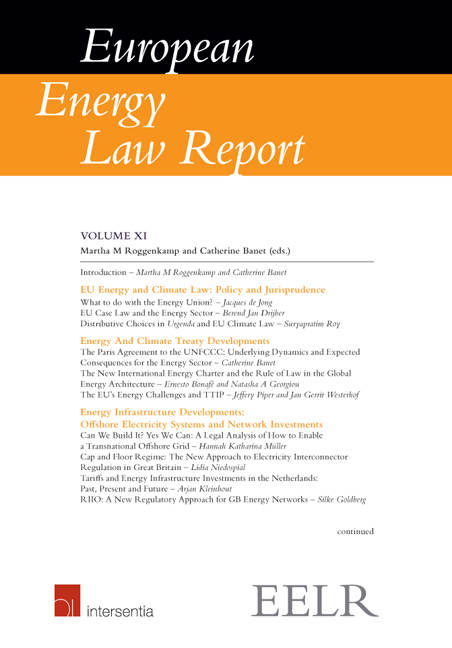Book contents
- Frontmatter
- Editorial
- Contents
- List of Abbreviations
- List of Contributors
- Introduction
- Part I EU Energy and Climate Law: Policy and Jurisprudence
- Part II Energy and Climate Treaty Developments
- Part III Energy Infrastructure Developments: Offshore Electricity Systems and Network Investments
- Chapter VII Can We Build It? Yes We Can: A Legal Analysis of How to Enable a Transnational Offshore Grid
- Chapter VIII Cap and Floor Regime: The New Approach to Electricity Interconnector Regulation in Great Britain
- Chapter IX Tariffs and Energy Infrastructure Investments in the Netherlands: Past, Present and Future
- Chapter X RIIO: A New Regulatory Approach for GB Energy Networks
- Part IV Heat Supply Legislation in the Eu
- Part V Security of Energy Supply and Safety
Chapter VII - Can We Build It? Yes We Can: A Legal Analysis of How to Enable a Transnational Offshore Grid
from Part III - Energy Infrastructure Developments: Offshore Electricity Systems and Network Investments
Published online by Cambridge University Press: 29 September 2018
- Frontmatter
- Editorial
- Contents
- List of Abbreviations
- List of Contributors
- Introduction
- Part I EU Energy and Climate Law: Policy and Jurisprudence
- Part II Energy and Climate Treaty Developments
- Part III Energy Infrastructure Developments: Offshore Electricity Systems and Network Investments
- Chapter VII Can We Build It? Yes We Can: A Legal Analysis of How to Enable a Transnational Offshore Grid
- Chapter VIII Cap and Floor Regime: The New Approach to Electricity Interconnector Regulation in Great Britain
- Chapter IX Tariffs and Energy Infrastructure Investments in the Netherlands: Past, Present and Future
- Chapter X RIIO: A New Regulatory Approach for GB Energy Networks
- Part IV Heat Supply Legislation in the Eu
- Part V Security of Energy Supply and Safety
Summary
INTRODUCTION
The European Union (EU) aims to increase its share of renewable energy whilst reducing CO2 emissions. In order to reach the EU-wide target of 20 per cent renewables in 2020, the energy sector needs to replace fossil fuels by using more renewable energy sources. This process of energy transition is one of the most important challenges of the coming decades. It requires engineers to develop the required technologies, economists to establish the most efficient approaches, and politicians to communicate goals to society and agree on the political will. Further, this energy transition requires the contribution of lawyers. Taking into account the findings of other disciplines and the political will, they need to analyze and understand the current legal regimes, identify the barriers to energy transition, and develop solutions of how to address the barriers and how to enable the required energy transition.
The Member States of the EU are required to reach a certain share of renewable energy in their final energy consumption by 2020. In reaching the renewable energy targets, the North Sea states consider increasingly offshore wind as an important renewable energy source. So far the development of offshore wind energy is still in its early stages and all offshore wind farms in the North Sea are consequently connected directly to the national grids, ie the coast where a connection to the national grid can be made (so-called radial connections). With the increasing scale of wind farms and their increasing distance from shore, it is considered more economical to connect wind farms to the grids of two or more countries. In the long term this could result in a transnational offshore electricity grid.
This chapter concentrates on the legal issues and requirements relating to such a transnational offshore electricity grid. The research this chapter builds on shows that the current international and national legal regimes contain legal barriers to the development of cross-border offshore wind energy projects. The most important barriers to the materialization of such projects are the legal uncertainty concerning applicable definitions of the various parts of the offshore infrastructure and responsibilities, the lack of incentives for the relevant parties to initiate such projects and operational issues. If the main legal and regulatory barriers were removed, a first set of cross-border offshore projects could be built, eventually leading to a transnational offshore grid.
- Type
- Chapter
- Information
- European Energy Law Report XI , pp. 145 - 164Publisher: IntersentiaPrint publication year: 2017

